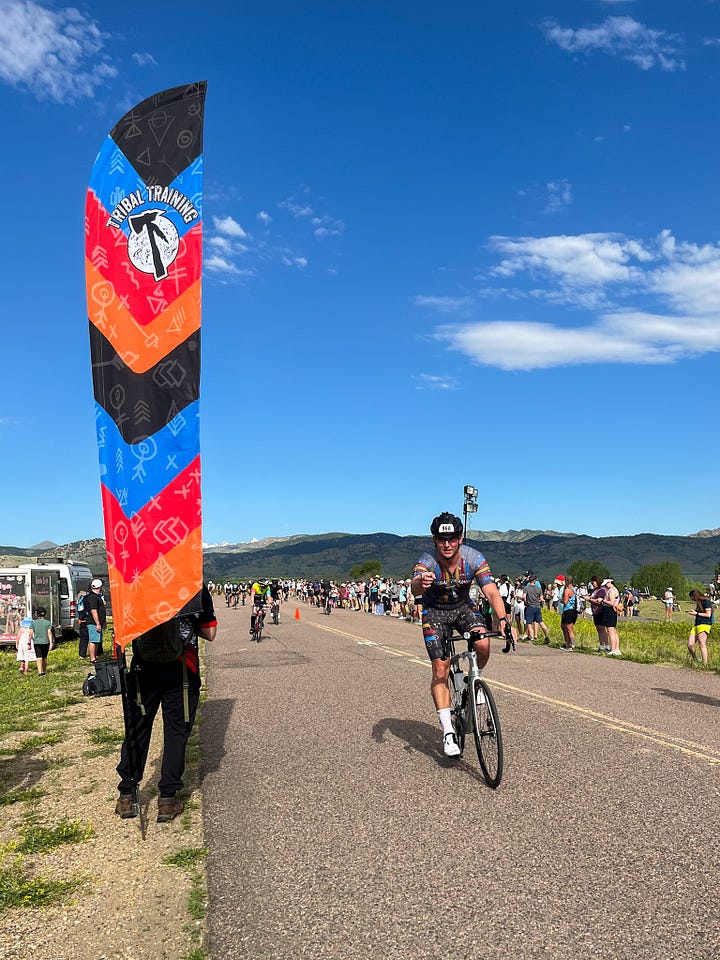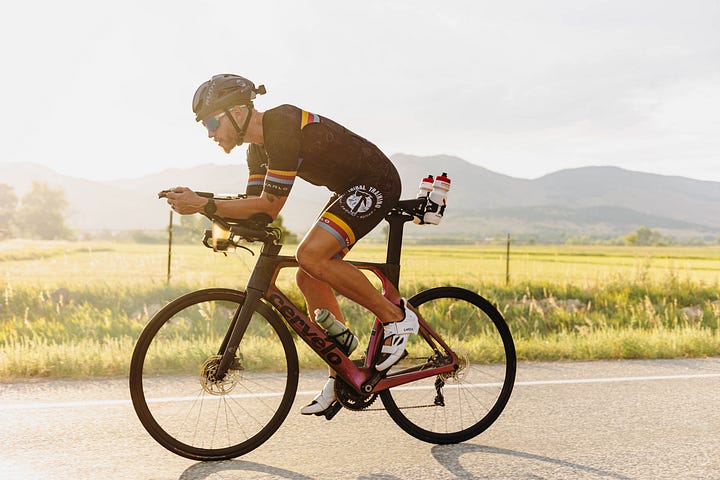Last week I had two athletes take down their first 70.3.
They both checked all the first timer boxes:
loved the experience
hardest thing they’ve ever done
signed up for their second race just days later


I was doing race debriefs with both of them and saw a common theme that inspired this post.
Solid swim
Great bike
Grind of a run
I am helping them both fix that. And want to share the knowledge with you here.
PSA: Don’t want to read through this?
I recorded this podcast that shares all the info.
You can also watch it on my YouTube channel here.
Start With The Goal In Mind
Here’s the #1 goal I hear from first timers taking on a 70.3:
I want to finish strong.
All advice below is to help you do this.
The Big Idea
A reminder on the most important triathlon fueling principle:
Fueling on the bike is all about setting up the run.
The 3 Most Common Mistakes
Here are the Top 3 bike fueling mistakes I see from first time 70.3 athletes:
Using different fuel on race day than used in training
Sometimes athletes have a “Jesus take the wheel” moment and pray that something brand new will save them from potential disaster on race day.
Every time they end up under-fueling. And the run is a grind.
Here’s what I observe when that happens:
There’s too much “new”…
new math to do on the fly
new decisions to make on what to eat
new challenges on race day that complicate it all
All while they’re trying to ride hard for 56 miles in your first 70.3 bike leg…
They don’t eat enough.
Here’s my advice on how to avoid this:
Be intentional with fueling on your 3+ hour rides. Then repeat on race day.
Keep it simple.
Too much dependance on gels and chews
“I was gonna have a few gels” doesn’t cut it.
Most gels are 100 calories and chews are around 150.
If these are your primary calorie source, you need to eat upwards of 10 (!!!) total packages to hit standard fuel targets (300 calories per hour) on the bike.
That’s too much math, decisions, operations, etc.
Remember: Keep it simple. Think less. Make it easy to hit your numbers.
I encourage athletes to use a sports mix that covers at least 600 total calories for their fuel plan.
That could be Skratch (high carb mix), Tailwind, Infinit, or any other brand.
The remainder of calories can be made up with gels, chews, bars, blocks, waffles, etc.
Too much relying on LMNT or other no/low calorie electrolytes
LMNT, Liquid IV, Skrach (Hydration Mix) and G1M Sport from BPN are the most common things I see athletes use.
LMNT has 0 cals
Liquid IV has 45 cals
Skratch and G1M Sport have 80 cals
That’s not enough…
And if you only have 2 bottle cages on your bike, these are wasting space that is needed for calories.
Fueling Feedback In Training
Here’s a Pro Tip to feel out your fueling and recovery on long rides:
Observe how you feel 2 to 4 hours after the ride.
Assuming your big ride is on Saturday morning…
are you exhausted running errands in the afternoon?
are you moving slow with your kids?
are you dying to lay on the couch?
are you irritable?
Or… do you have high energy through it all?
Don’t delay recovery observation to the next day (after dinner, sleep, breakfast).
It’s a bike ride dawg….
You should bounce back the next day no matter what (99% of the time).
Basic Fuel Goals and Targets
Here are the standard metrics I give to athletes:
300 calories per hour
2 bottles of water per hour (40 oz)
Of course this can be individualized, tested and all that jazz. And more trained athletes will take in more calories than this.
But this the best place to start.
Now let’s break down how we’re getting this.
Basic Bike and Aid Station Set Up
You should have 3x bottle cages on your bike.
a road bike should have 2 in the frame with 1 added between the clip on aero bars
a TT bike should have 1 in the frame, 1 aero bottle and 1 (or 2) rear cages behind the seat


And each 70.3 has 3x Aid Stations. These are most often at…
mile 15
mile 30
mile 45
Time Goals and Calorie Projection
I have most first timers target doing the bike in 3 hours. That’s an 18 mph average.
(3:30 is 16 mph avg. 3:15 is 17 mph avg. Adjust as needed)
3 hours x 300 cals/hour = 900 total calories needed
3 hours x 2 bottles/hour = 6 bottles
Here’s the easiest way to hit these targets:
2x bottles should start the race with 300 calories each (600 total)
final 300+ calories can come from gels, chews, solids, etc.
you should get 1 fresh water (or more) at every single AS
How To Handle Aid Stations
I tell my athletes to use throwaway bottles for races. You can get cheap ones at the Ironman Expo or online.
Drink the first 300 calorie bottle by AS 1
Toss it and put a fresh water from the AS back in your bottle cage.
Grab a second bottle to drink from in the moment [hydration insurance] and toss before leaving the AS.
Or use it to spray yourself off and cool down.
Drink the second 300 calorie bottle by AS 2
Repeat process above as you roll through the AS.
Use gels, chews, solids, etc. for next 300 calories through AS 3
Repeat AS process above.
Finish ride and take in an final calories
Bonus Tips
You should pee at least 1x during a 70.3 bike ride
If you don’t, you are going into the run dehydrated.
I encourage athletes to pee on the bike. Wait for a descent, pick your ass up out of the seat and stop pedaling to relax your pelvis.
Spray yourself down at the next AS as needed.
It’s OK to stop at Aid Stations
Time focused athletes should roll right through Aid Stations without stopping.
But if you aren’t crazy time focused, stopping will help ensure you get enough total fuel in.
This also gives you a chance to use the AS port-a-potty if you prefer.
I like caffeine
I take 1-2x 100 mg caffeine pills during a 70.3 bike ride.
Electrolytes
I was intentional to leave electrolytes out of this write up.
I see beginners over-prioritize electrolytes and under-prioritize calories. And I want to help you flip that.
Plus, the sports mix (Skratch, Tailwind, Inifinit, etc.) you use should have sufficient electrolytes.
Any Questions?
Drop a comment if you have additional questions on this.
I want to make sure this write up provides you with support on every aspect of your fueling strategy.




This was an excellent breakdown for beginners! That's part of the reason why I always advocate people getting a coach for a 70.3 (among other reasons). You can fake your way through a sprint or an Olympic, but a 70.3 and of course an IM, is an entirely different thing. I'm always surprised at the number of people who think they're going to "just wing it" with their nutrition. But it's hard because there's so much misinformation, especially on social media, with these trendy super-high carb counts per hour that aren't realistic for most people. I wrote a blog post about doing IM FL without using any on course aid station products. I carried my own carb mix and supplemented with water at aid stations, then picked up the second batch at special needs. I wanted to show people how they can use whatever formula that works for them in training. You don't have to use on course nutrition. It is possible to carry your own nutrition, just takes more planning. https://bybrittanyvermeer.com/2024/03/how-i-did-an-ironman-without-using-aid-stations/